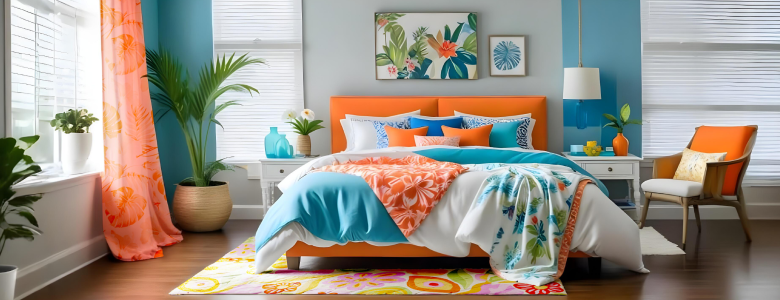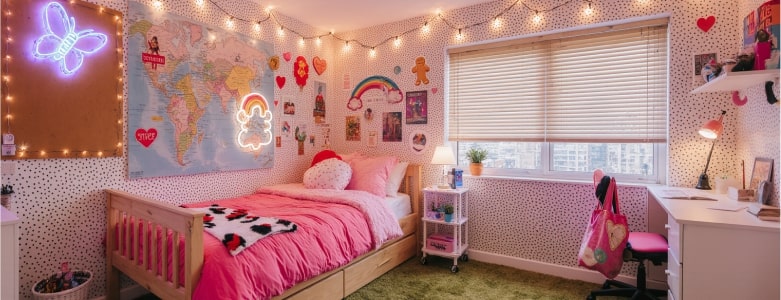Your bedroom is more than just a place to crash. It’s your morning launchpad, your nighttime hideaway, and even your think tank, nap zone, or makeshift office. But here’s the catch: how this space looks and feels can significantly impact your mood, sleep quality, and mental well-being.
Designing a cozy, calming bedroom isn’t just about aesthetics—it’s scientifically supported. From the colors on your walls to the glow of your bedside lamp, every small element can help (or hinder) your journey to feeling more relaxed, focused, and recharged. That’s why so many people are turning to sleep-friendly home decor ideas to improve both their space and their sleep.
Ready to transform your bedroom into a mood-lifting sanctuary? Let’s break down the psychology behind bedroom décor and how to make your space feel like the best version of home.
1. Your Mood Reflects Your Environment
The connection between your surroundings and your emotions isn’t just a guess—it’s based on environmental psychology. It shows how the physical environment influences the way we think, feel, and behave. And the results are fascinating:
- Disorganized clutter and chaotic arrangements can trigger stress and make it harder to concentrate or sleep.
- Calm, organized spaces promote a sense of control, reduce anxiety, and boost your well-being.
- Even elements like lighting, layout, and wall color influence how you feel in your bedroom.
2. Mood Behind the Hue: What Your Walls Might Be Saying
Color is one of the simplest (and most powerful) ways to influence the mood of a room. It doesn’t just change how a room looks—it changes how it feels. That’s why being aware of the psychological effects of bedroom color choices is a foundation of smart interior design.
- Cool tones such as soft blues and muted greens are the best colors for a relaxing bedroom. They are champions of relaxation and are shown to promote better rest. They lower your heart rate, calm your mind, and create a spa-like serenity that’s ideal for unwinding.
- Warm hues like reds, oranges, and bright yellows tend to energize, being more suitable for kitchens or workout areas rather than bedrooms. These hues can stimulate the brain and raise alertness—perfect in the morning, not so much at night. Incorporating them into sleeping areas may disturb your body’s winding-down ability and end up affecting how quickly you fall—and stay—asleep.
- Color isn’t just science—it’s also personal. If pale pink or a rich terracotta puts you at ease, that’s what matters most. Your space should reflect your taste and help you rejuvenate. And don’t underestimate the power of accents—wallpaper, tapestry, or any personalized wall art can elevate a bare wall while influencing your mood.
3. Layout & Clutter: When Less Really Is More
How your furniture is arranged and how much stuff is lying around can directly affect your stress levels.
- Clutter has been linked to increased cortisol (the stress hormone) and decreased focus—especially for women.
- A well-laid-out room feels spacious, breathable, and easier to relax in.
Try these tips:
- Anchor your bed where it feels grounded and safe (against a wall or tucked in a corner often works best).
- Keep work gear out of sight or out of the room, if possible.
- Use smart storage such as bins, bed drawers, and minimalist nightstands to conceal the mess.
Remember: You don’t need a Pinterest-perfect space. You just need a room that is serene and soothes your spirit.
4. The Right Light: Your Shortcut to Cozier Bedroom Vibes

Good lighting = good vibes. It influences your energy levels, your sleep, and your overall mood.
- Natural daylight is a major mood booster. It regulates your circadian rhythm, maintains your energy, and boosts serotonin (your feel-good hormone). So let the sunshine in! Open up those curtains and bask in the daylight.
- Soft, warm lighting at night signals to your brain that it’s time to relax and prepare for sleep.
- Avoid harsh white lights and blue lights from smartphones and laptops before bed as they disrupt melatonin secretion and can throw off your sleep cycle.
Layer Your Lighting (Ambient, Task, Accent)
- Add table lamps or wall sconces for coziness and flexible mood control.
- Fairy lights, salt lamps, or low-watt bulbs can provide a cozy nighttime glow.
- Allow light to naturally filter through sheer curtains during the day.
5. Personal Touches: Decor That Speaks to You
Your bedroom should be an expression of You. That’s where the emotional power of personalization comes in.
- Meaningful decor, like photos, art prints, keepsakes, and your favorite books, can bring comfort, familiarity, and joy.
- Personalized spaces increase our sense of control and belonging—two of the most important components of emotional health.
But Here’s the Trick: Be Selective
- Less is more! Too many items can create visual and emotional clutter.
- Instead, prioritize a few special pieces that spark positive memories, make you smile, and bring you calm.
- Display a few thoughtful pieces, such as a framed photo on the nightstand, a cozy quilt from your grandmother or a scented candle in your favorite fragrance, instead of overfilling your space.
- And when comfort is concerned, choose soft furnishings for better sleep like bed pillows, cushions, and throw pillows to add warmth and texture without overwhelming the room.
6. Sleep Like Royalty: Choose Best Bedding for Sleep Quality
Let’s not forget one of the most significant factors: bed linen. Understanding how bedding affects sleep quality is essential when designing a place for rest and rejuvenation.
- Breathable fabrics like cotton, bamboo, and linen help regulate body temperature.
- Layering with soft textures promotes physical and emotional comfort.
- Moisture-wicking fabrics reduce night sweats and help keep you asleep longer.
The best bedding for better sleep is what feels right for you—whether it’s crisp and cool or soft and cozy. Consider how sheets, duvets, and pillows affect not just your body but also your mindset.
Look for comfortable bedding decor that contributes to a relaxing atmosphere while serving a practical purpose.
7. Small Tweaks, Big Impact: Easy Ways to Refresh Your Bedroom
Renovating your bedroom doesn’t have to involve swinging a sledgehammer or spending a fortune. Mostly, the smallest shifts bring the most calm. If you’re seeking better sleep, a clearer mind, or just a prettier spot to land at night—these steps can help turn your bedroom into your personal recharge zone. Here’s where the magic begins:
- Start Small, Dream Big: Change doesn’t have to come in giant waves. Throw a plush rug. Swap that stiff bedding for something soft and breathable. Even a basic lamp with a warmer color can turn your space from sterile to soothing.
- Splurge with Purpose: Invest where it counts. A cloud-like mattress, supportive bed pillows, or blackout curtains can significantly transform the feel of your room and your waking experience. Prioritize the essentials that impact your comfort, rest, and overall wellness.
- Let Scents Do the Heavy Lifting: Aromatherapy for sleep improvement is real. A whiff of lavender, chamomile, or eucalyptus has the power to soothe your mind instantly. Use a diffuser for a gentle, continuous scent or light a soy candle for a more ambient touch. The best bedroom scents for relaxation can be your secret weapon for winding down.
- Invite Nature In: Creating a calming bedroom ambiance can be as simple as adding a touch of green. A small amount of greenery, such as aloe vera or spider plants, adds more than just aesthetic appeal to your space and helps cultivate a peaceful vibe. Think of them as quiet, leafy roommates who ask for little and give a lot. You’ll enjoy an instant mood boost while creating a cleaner, more breathable sleep environment.
- Power Down the Tech: Your bedroom isn’t a movie theater—or a second office. One of the most effective relaxing bedroom design tips is to kick out the screens (or at least set them to Do Not Disturb). Blue light fiddles with your melatonin and scrolling at night is a ticket to restless sleep. Old-school alarm clocks? They deserve far more praise than they get. Get yourself into bed screen-free and observe just how much better it becomes to relax.
- Keep It Cool: Temperature is more significant than you may think. According to sleep science, the ideal temperature range is between 60–67°F. If the temperature is too warm or too cold, it can cause your body to toss and turn. You have the option to use fans, adjust your bedding, or rely on a smart thermostat to manage the temperature, allowing you to concentrate on unwinding.
Finally…
Your bedroom should be your calm in the chaos—a place that helps you rest, recharge, and feel truly at home. Thoughtful touches, like understanding color psychology for bedroom decor or learning sleep-enhancing home decor trends, can make a real difference in how restful your space feels. With just a few tweaks, you can turn your room into the cozy, mood-boosting retreat you deserve.





No Comments